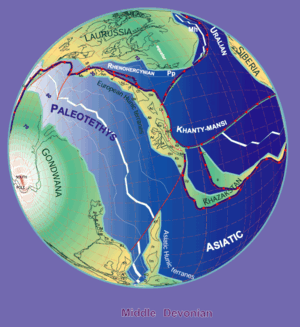Río Cachirí Group
| Río Cachirí Group Stratigraphic range: Devonian 419–360 Ma | |
|---|---|
| Type | Geological group |
| Unit of | Cesar-Ranchería Basin, Serranía del Perijá |
| Sub-units | Caño Grande Fm., Caño del Oeste Fm., Campo Chico Fm., Los Guineos Fm. |
| Underlies | Carboniferous sequence |
| Overlies | Perijá Formation |
| Thickness |
~1,100 m (3,600 ft) (Colombia) 2,438 m (7,999 ft) (Venezuela) |
| Lithology | |
| Primary | Shale, sandstone |
| Other | Limestone |
| Location | |
| Coordinates | 10°50′03″N 72°14′23″W / 10.83417°N 72.23972°WCoordinates: 10°50′03″N 72°14′23″W / 10.83417°N 72.23972°W |
| Region |
Cesar, La Guajira Zulia |
| Country |
|
| Extent | ~110 km (68 mi) (Venezuela) |
| Type section | |
| Named for | Río Cachirí |
| Named by | Liddle |
| Location | Mara |
| Year defined | 1928 |
| Coordinates | 10°50′03″N 72°14′23″W / 10.83417°N 72.23972°W |
| Region | Zulia |
| Country |
|
| Thickness at type section | 2,438 m (7,999 ft) |
 Paleogeography of the Middle Devonian 380 Ma, by Stampfli & Borel | |
The Río Cachirí Group (Spanish: Grupo Río Cachirí, PZc) is a geological group of the Cesar-Ranchería Basin, Colombia and the Serranía del Perijá of the northernmost Colombian and Venezuelan Andes. The group of shales, sandstones and limestones is of Devonian age and has a maximum thickness in the Venezuelan section of 2,438 metres (7,999 ft). The group contains abundant fauna; crinoids, bryozoa, brachiopods and molluscs have been found in the group.
Etymology and definition
The formation was defined by Liddle in 1928 in Río Cachirí, part of Mara, Zulia, in the Venezuelan part of the Serranía del Perijá, and the same author subdivided the group into three formations in 1943. In 1972, Bowen added a fourth formation to the group.[1]
Description
Lithologies
The group contains black, grey and red shales, grey micaceous sandstones, quartzitic sandstones and red and bluish grey limestones.[1]
Stratigraphy and correlation
The Río Cachirí Group, dated to span the Devonian, is subdivided into the Caño Grande, Caño del Oeste, Campo Chico and Los Guineos Formations. The maximum thickness has been recorded in Venezuela, with 2,438 metres (7,999 ft), while the thickness on the Colombian side of the range does not exceed 1,100 metres (3,600 ft).[1] The group is recognised along a section of approximately 110 kilometres (68 mi) in the Venezuelan terrain.[2] The group unconformably overlies the Perijá Formation and is overlain by an unnamed Carboniferous sequence. The Río Cachirí Group is time-equivalent with the Floresta and Cuche Formations of the Floresta Massif, Altiplano Cundiboyacense and the Quetame Group of the Eastern Ranges.[3] The sediments of the Río Cachirí Group were deposited in an epicontinental sea at the edge of the Paleo-Tethys Ocean.[1]
Fossil content
The group contains abundant fossils of crinoids, bryozoa, brachiopods and molluscs as Acrospirifer olssoni, Spirifer kingi, Leptaena boyaca, Fenestella venezuelansis, Neospirifer latus, Composita subtilita, Phricodrotis planoconvexa and Pecten sp.[4]
Outcrops
.jpg)
Apart from its type locality on the eastern flank of the Serranía del Perijá in Zulia, Venezuela, the formation is also found in other parts of the mountain range, on the Colombian western side in the east of San Diego and Curumaní, Cesar.[5][6]
See also
References
Bibliography
- Ayala Calvo, Rosa Carolina. 2009. Análisis tectonoestratigráfico y de procedencia en la Subcuenca de Cesar: Relación con los sistemas petroleros (MSc. thesis), 1–255. Universidad Simón Bolívar. Accessed 2017-06-14.
- García González, Mario; Ricardo Mier Umaña; Luis Enrique Cruz Guevara, and Mauricio Vásquez. 2009. Informe Ejecutivo - evaluación del potencial hidrocarburífero de las cuencas colombianas, 1–219. Universidad Industrial de Santander.
- Hernández Ferrer, Mauricio Esteban. 2011. Actualización de la geología de superficie en la Sierra de Perijá mediante la utilización de imágenes satelitales, 1–125. Simón Bolívar University. Accessed 2017-08-03.
Maps
- Colmenares, Fabio; Milena Mesa; Jairo Roncancio; Edgar Arciniegas; Pablo Pedraza; Agustín Cardona; César Silva; Jhoamna Romero, and Sonia Alvarado and Oscar Romero, Felipe Vargas, Carlos Santamaría. 2007. Plancha 34 - Agustín Codazzi - 1:100,000, 1. INGEOMINAS. Accessed 2017-06-14.
- Hernández, Marina, and Jairo Clavijo. 2008. Plancha 48 - La Jagua de Ibirico - 1:100,000, 1. INGEOMINAS. Accessed 2017-06-14.